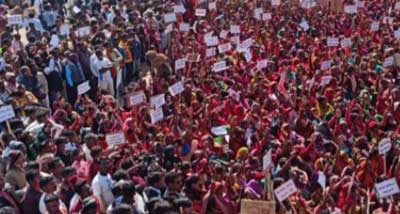Relevance: GS-2: Government Policies and Interventions for Development in various sectors and Issues arising out of their Design and Implementation.
Relevance: GS-1: Social Empowerment, Communalism, Regionalism & Secularism.
Key Phrases: Regional languages, “Infringement” on the rights, Linguistic minority, Pluralism, Language-development oriented, Language-survival oriented, Linguistic affinity, Multilingualism, Scheduled Language.
Why in News?
- Several parts of Jharkhand are seeing massive protests against the inclusion of Bhojpuri and Magahi as 'regional languages' in district-level competitive examinations for government jobs. Why are the protests taking place? What kind of examinations are these?
- Hundreds of protesters, including women, have been marching with placards, raising slogans against the government mainly in the east-central districts of Jharkhand. The protests have gathered momentum since the last week of January, and some very large gatherings have been seen in the last few days.
Why are the protests taking place?
- On December 24, the Jharkhand government issued a notification to include Magahi, Bhojpuri, and Angika among others as regional languages in the district-level selection process through exams conducted by the Jharkhand Staff Selection Commission (JSSC).
- The notification triggered resentment in a section of people, who saw the inclusion of Bhojpuri and Magahi as an “infringement” on the rights of Adivasis and Moolvasis.
- The protesters argue that the “low population” of Magahi and Bhojpuri speakers in these districts did not “warrant” the inclusion of these languages in the job selection process.
Many political leaders claimed that more than 1 crore people in Jharkhand speak Bhojpuri, Magahi, and Angika, and recalled the “immense contribution” of Bhojpuri and Magahi speakers to the state.
INGUISTIC REGIONALISM IN INDIA
- Language is closely related to culture and therefore to the customs of people. Since independence in 1947, linguistic affinity has served as a basis for organizing interest groups; the "language question" itself has become an increasingly sensitive political issue.
- In India the issue is not only of multilingualism, but also with the rights of many millions of speakers of lesser used minority languages. As the political and cultural context privileges some major languages, linguistic minorities often feel discriminated against by the current language policy of the Union and the States
Language Policy of India:
- The language policy of India is basically embodied in Part XVII of the Indian Constitution along with the 8th Schedule in reference to Articles 344 and 351 (which specify the languages of India for purposes mentioned in these 2 articles), and the articles concerning Fundamental Rights regarding language, education, and culture etc.
- The language policy gives full freedom to the states to choose any language or languages spoken in regions as their regional languages and to have one or more of them as official languages by different states.
- However, for the Union, the Constitution prescribes Hindi in Devanagari script for official purposes along with English as an associate official language.
- The Language Policy of India relating to the use of languages in administration, education, judiciary, legislature, mass communication, etc., is pluralistic in its scope. It is both language-development oriented and language-survival oriented.
- The policy is intended to encourage the citizens to use their mother tongue in certain delineated levels and domains.
States have been accused of failure to fulfil their obligations under the national constitution to provide for the education of linguistic minorities in their mother tongues, even when the minority language is a Scheduled Language.Therefore a strong safeguard mechanism is necessary to protect minority languages.
The Scheme of the Safeguards for the linguistic minorities includes:
- The provision for instruction through mother tongue at the primary stage of education; teaching of minority languages at the secondary stage of education;
- The registration of language preference of the linguistic minority pupils to facilitate inter-school adjustments; provision for text-books and teachers in minority languages; translation and publication of rules, regulations and notices, etc. in minority languages.
- Declaration of minority languages as additional Official language in districts, where their speakers constitute 60% or more of the district population;
- Receipt of, and reply to representations for redress of grievances in minority languages;
- Use of minority languages in recruitment tests to the State Services;
- Setting up of proper machinery for effective implementation of the safeguards for the linguistic minorities at the State and District levels; issue of publicity material in minority languages detailing the Safeguards available to the linguistic minorities, etc.
Conclusion:
- Under such circumstances, like in the Jharkhand linguistic protest, members of linguistic minorities may feel they and their language are oppressed by the majority, while people who are among linguistic majorities may feel threatened by what some might consider minor concessions. This may lead to linguistic regionalism.
- Hence steps should be taken to place language as a source of unity of the country by recognizing linguistic diversity and initiating tolerance for each culture.
Sources: Indian Express
Mains Question:
Q. What do you understand about linguistic regionalism? How India has managed to secure linguistic pluralism in growing lingual conflicts post independence. [250 words]









